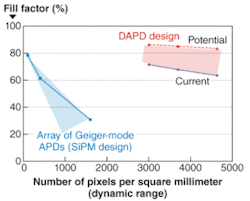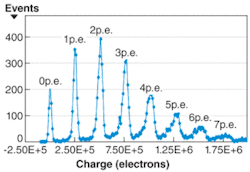SINGLE-PHOTON DETECTORS: Discrete amplification dramatically improves single-photon detection
KRISHNA LINGA
To achieve single-photon sensitivity, researchers have developed and customized numerous detector technologies to suit particular applications such as photomultiplier tubes (PMTs), linear and Geiger-mode avalanche photodiodes (APDs), and hybrid photon detectors. The need for ever more sensitive, compact, rugged, and inexpensive optical sensors in the visible and near-infrared region of the spectrum is increasing and is particularly acute in the fields of the biological sciences, medicine, astronomy, and high-energy physics. Applications such as fluorescence and luminescence photometry, absorption spectroscopy, scintillator readout, lidar, and quantum cryptography require extremely sensitive optical sensors often in adverse environments, such as high magnetic fields.
In many of these applications, the PMT is the detector of choice. However, the so-called silicon photomultiplier devices, and more recently, the new generation of multichannel discrete-amplification photon-detector (DAPD) devices, have begun to rival the PMT, with many parameters comparable to or better than those of the vacuum-tube devices. In addition, these PMT rivals offer all of the benefits of solid-state semiconductor technology, such as high detection efficiency, compactness, ruggedness, insensitivity to magnetic field, ability to create arrays, ease of electronics integration, and high-volume, low-cost manufacturing.
Discrete amplification
The solid-state discrete-amplification (DA) mechanism internally amplifies low-level electrical signals to optimize flexibility and performance characteristics.,1-4 The design distributes low-level signals into individual photoelectron components, amplifies the signals in separate amplification microchannels to a precisely determined level, and then combines them into one analog output signal. This enables designers to optimize specific performance characteristics without having to sacrifice others. The DA approach overcomes the inherent limitations of traditional silicon photomultiplier designs and permits the creation of more-sensitive photodetectors that can be optimized for specific applications.
High energy resolution, coupled with excellent timing resolution, make these devices a natural photodetector choice for many applications that use scintillators. Combined with inherent excellent voltage and thermal stability, solid-state DA photomultipliers are an attractive choice for medical imaging applications such as positron emission tomography (PET) and computerized axial tomography (CAT or CT) scanners, high-energy physics experiments, x-ray spectral fluorescence analyzers, and other applications. The DAPD enables the creation of lab-on-a-chip devices and efficient photodetection to analytical biomedical instrumentation such as flow cytometers, microplate scanners, and immunoassay readers. They also show promise in applications including light scattering, laser-scanning confocal microscopy, Raman spectroscopy, and optical coherence tomography.
We have designed and developed a silicon photodetector with high gain, low excess noise factor, high dynamic range, and broad spectral width using the discrete-amplification (DA) approach to internal-avalanche amplification. The DAPD allows analog detection of low-level optical signals and short pulses ranging from one photon to several thousand photons.
Flat spectral response
One of the main objectives of DAPDs is to achieve spectral response from ultraviolet (UV) to near-infrared wavelengths. Use of DA technology enables flat spectral sensitivity between 300 and 700 nm, unusual for a silicon photodetector of this level of nanometers (see Fig. 1). Depending on the specific application, the spectral sensitivity of DAPDs can be easily customized using an appropriate antireflection coating that optimizes either a specific wavelength range, the highest detection efficiency, or for the entire spectral range. The flattest region on the spectral response curve is between 300 and 600 nm. Some increase in spectral sensitivity at wavelengths shorter than 350 nm is most likely caused by the quantum yield increase in silicon (more than one electron-hole pair being generated by a single UV photon). The spectral response can be extended further into wavelengths shorter than 300 nm.
An important feature of DA technology is its ability to provide a high density of micropixels (wide dynamic range) combined with high photon-detection efficiency (PDE). This is because of a much higher fill-factor than that of conventional arrays of Geiger-mode APDs (see Fig. 2).5, 6 In the analog mode, when the signal amplitude is within the dynamic range of the detector, its output amplitude is proportional to the number of incident photons in the pulse (the number of active amplifier channels). For stronger signals, the device starts to saturate, and the output signal amplitude cannot exceed the number of channels multiplied by the single-electron-response amplitude of a channel. Analog detection requires that the photoelectrons simultaneously generated by the same light pulse be distributed over the amplifier channels in such a way that no more than one photoelectron travels through a channel at the same time. Thus, the total number of amplifier channels defines the device’s dynamic range for very short light pulses.To increase the dynamic range of a detector with a given active area, we must increase the density of channels, which, in turn, leads to a decrease in the fill-factor (and hence to PDE). This trade-off between PDE and dynamic range is a limitation of both the described technology and that of the traditional arrays of Geiger-mode APDs. However, discrete-amplification technology overcomes this trade-off with a high PDE of greater than 50% for a rather wide photodetector dynamic range of greater than 4500 pixels/mm2. The ability to simultaneously achieve high values of photodetection efficiency and dynamic range is a significant advantage of DAPD technology over the traditional array of Geiger-mode APDs approach.
For short pulses, dynamic range is simply a function of the number of micropixels. For longer pulses, dynamic range is further dependent on the ratio of the reset time of active micropixels to the optical pulse duration because the same micropixel might be active more than once over the duration of the pulse.
Fast response time
Fast response time of a photodetector is important for many applications, especially those involving measurements within a narrow time gate. Discrete-amplification technology provides very fast time response as well as high gain-bandwidth product, which is a prerequisite for the high-speed detection of low-level signals. The response time of a single-electron-response pulse as an output of a 1 mm active-area-diameter DAPD is approximately 1.4 ns full-width half-maximum (FWHM) at the gain level of 2.8 × 105. The timing resolution of the detected pulses, evaluated as the transit time spread (jitter) distribution at FWHM, is less than 300 ps.
The mechanism of discrete amplification, the foundation of DA technology, is almost noiseless due to the binary type of amplification in separate channels, with a very small dispersion of their output values. Excess noise factor (ENF), a measure of avalanche amplification noise, is typically less than 1.05 at room temperature for DAPD photodetectors. The low ENF and multichannel design provide the ability to count the number of photons in an individual signal pulse with very high accuracy (see Fig. 3). The data show that N and N + 1 photoelectrons are clearly resolved. This single-photon differentiation is not possible even with the best PMTs because their ENF is much higher (more than 1.3).An important advantage of DA technology is its wide operating voltage range, and voltage and thermal stability. The DA device can be operated up to 10 V above the breakdown voltage. The measured results show that the operating voltage variation is less than 30 mV/°C and the gain variation is less than 0.5%/°C. These unique performance benefits enable the development of large detector arrays that would use a single reverse bias, with array elements having only very minor variations of basic parameters at the same voltage.
REFERENCES
- D. Shushakov and V.E. Shubin, “High sensitivity, high resolution detection of signals,” U.S. Patent 6,885,827.
- D. Shushakov and V.E. Shubin, “High sensitivity, high resolution detection of signals,” U.S. Patent 7,085,502.
- A. Krutov et. al, Proc. of SPIE 5343 (2004).
- K. Linga et al., Proc. of SPIE 6083 (2006).
- .G. Moser et al., CALOR 06, June 5-9, 2006.
- S. Uozumi, Proc. of Vienna Conf. on Instrumentation 2007, Feb. 19-24, 2007.
Krishna Linga is a consultant to Amplification Technologies, 1400 Coney Island Ave., Brooklyn, NY 11230; e-mail: [email protected]; www.amplificationtechnologies.com.


